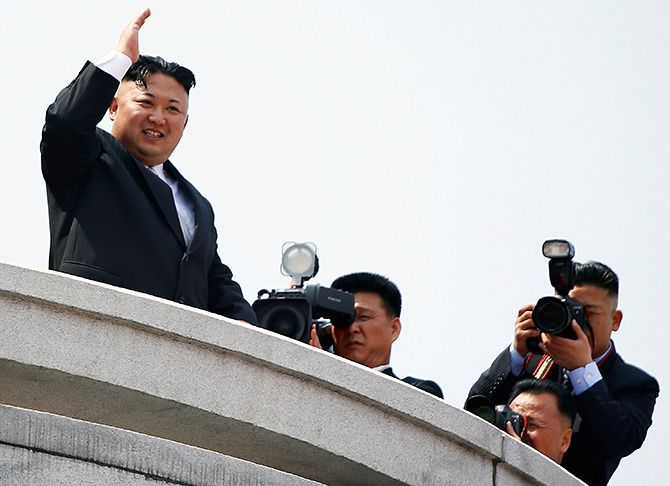'Pyongyang's strategy seems to be a cry to be treated as equal with the US and Beijing and this aspiration is premised on equipping itself with weapons as devastating as theirs,' says Rajaram Panda.

Days after Moon Jae-in moved to the Blue House as South Korea's president and was yet to fully settle in office, North Korea test-launched a ballistic missile to unsettle Moon despite his advocacy of reconciliation and dialogue with Pyongyang to curb its nuclear ambitions in a clear departure from previous conservative governments' policy of confrontation.
Such provocative actions on Kim Jong-un's part pose fresh challenge to Moon and other powers.
The missile flew some 800 km (500 miles) before landing in the Sea of Japan. Preliminary examination of the missile by the US Pacific Command said the flight was 'not consistent with an intercontinental ballistic missile.'
The real worry is Pyongyang is consistently working to master the technology needed to field nuclear-tipped missiles that can reach the US mainland.
The missile was believed to have been fired from near Kusong in North Phyongan province. Past satellite rocket launches have been called clandestine tests of ICBM technology, but North Korea is not believed to have tested a true intercontinental ballistic missile yet.
North Korea has remained consistent in its stand that it will continue to bolster its nuclear capability unless the US abandons its hostile policy.
The launch came as troops from the US, Japan and two European nations gathered on remote US islands in the Pacific for drills aimed as a message to North Korea.
The USS Carl Vinson, an aircraft super-carrier, is also engaging with South Korean navy ships in waters off the Korean peninsula.
Between the previous liberal era a decade ago and now, North Korea has made considerable advance in its nuclear programme. This could put immense constraint on Moon to return to the policies that he envisages.
Was it an ICBM?
Though the US Pacific Command felt the launched missile 'was not consistent with an intercontinental ballistic missile,' the missile took an unusual high-altitude ballistic path, indicating that it was a new two-stage liquid-fuelled rocket capable of flying up to 4,500 km.
After Japanese experts analysed the trajectory of the projectile's flight, Japan's Defence Minister Tomomi Inada said the missile was a new type fired in a high-angle orbit, reaching an altitude of more than 2,000 km and flying for 30 minutes, before coming down in the Sea of Japan after a total flight of about 700 km, but not reaching the Japanese exclusive economic zone.
The Americans were not overtly worried. According to Union of Concerned Scientists Co-Director David Wright, the North Korean missile was not an ICBM. According to him, if flown on a standard trajectory, the missile would have a range of up to 4,500 km.
Guam, an American territory with two large US military bases, is 3,400 km away from North Korea and until now had been considered beyond the range of the most powerful rocket North Korea is known to have developed, the Musudan, with a range of about 3,000 km.
The latest missile launch indicates Pyongyang may have leapfrogged its troubled Musudan series of missiles.
Japan and South Korea are already within range of North Korea's missiles.
While South Korea is within target of North's Scud missiles with a 500 km range, Japan could come under attack from Pyongyang's 1,000 km to 1,300 km range Rodong missiles.
The latest weapon, the Hwasong-12, capable of carrying a 'heavy nuclear warhead' as claimed by Pyongyang, puts US bases on the Pacific island of Guam within striking distance.
While debates about the range of the latest missile continues, the unanimous opinion is that the new missile could be a stepping stone to a properly working ICBM, which could fundamentally change assessments of the threat posed by Pyongyang.
The latest missile launch also suggests that Pyongyang is closer to an operational ICBM than had been previously estimated.
A functional ICBM would need a nuclear warhead that can be mounted on to a missile.
After conducting five nuclear tests, it could be suspected that Pyongyang has already in its possession a compact warhead that can be mounted on to a missile.
What does Kim Jong-un want?
South Korea's new president has voiced his desire to visit Pyongyang and open up a dialogue with Kim Jong-un. So far, Kim has remained unresponsive to peace overtures from either US President Donald Trump or Moon.
It is possible that Pyongyang wants to secure a position of strength before a return to the negotiating table with enhanced bargaining leverage.
Pyongyang's strategy seems to be a cry to be treated as equal with the US and Beijing and this aspiration is premised on equipping itself with weapons as devastating as theirs, which is why advances on weapon capability continue.
As usual, condemnation followed. Trump called the launch 'unacceptable' and repeated threats of military action.
Moon called an emergency national security meeting but avoided making any statement on the launch.
Japan's Prime Minister Abe Shinzo reacted strongly to the launch as 'absolutely unacceptable' and that Japan shall respond resolutely.
The White House saw the missile launch 'as a call for all nations to implement far stronger sanctions against North Korea.'
Strangely, North Korea's action came soon after Trump had said he would be 'honoured' to meet Kim Jong-un 'under the right circumstances.' This led Nikki Haley, the US ambassador to the United Nations, to say that 'having a missile test is not the way to sit down with the president.'
China, still North Korea's only major ally and key trading partner, is displeased with Pyongyang.
While opposing Pyongyang's violation of UN Security Council resolutions, Beijing called for restraint to avoid increasing tensions in the region.
Russian President Vladimir Putin, who was in Beijing for an international summit, expressed concern about the missile test and the escalation of tensions. Noticing the missile impacting Russia more than Japan, Trump made an indirect appeal to Moscow for stronger cooperation to counter Pyongyang.
The UN Security Council condemned the missile test and vowed strong measures, including sanctions, to derail Pyongyang's nuclear weapons programme. In a unanimous statement supported by China, the Council vowed to punish Pyongyang's 'highly destabilising behaviour' and demanded a halt to any further nuclear or missile tests.
Despite so many sanctions which have failed to bite the rogue State, what else is left to put further pressure on North Korea to obtain compliance?
Moon feels there is still scope to explore other options and will visit Washington in June for a summit with Trump. It is doubtful if any consensus can be reached between the two leaders on the North Korean issue as their declared policies seem to come into conflict with each other.
Will diplomacy prevail to prevent a cataclysmic scenario from evolving in the Korean peninsula?
Dr Rajaram Panda is currently Indian Council for Cultural Relations India Chair Visiting Professor at Reitaku University, Japan. The views expressed are the author's own and do not represent either of the ICCR or the Government of India.
IMAGE: North Korean leader Kim Jong-un waves to people attending a military parade marking the 105th birth anniversary of the country's founder Kim Il-sung, in Pyongyang, April 15, 2017.
Towards the end of every parade, it is tradition for the North Korean leader to come to the edge of the balcony from where he watches the proceedings and wave to foreign and local dignitaries sitting on either side of the building.
The photographer on the far right has his hair styled in a similar way to Kim Jong-un, a common refrain amongst his bodyguards, aides and the photographers which surround him.
Photograph: Damir Sagolj/Reuters










